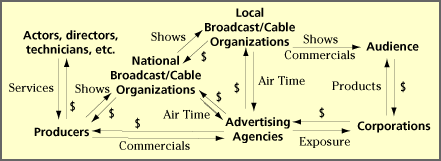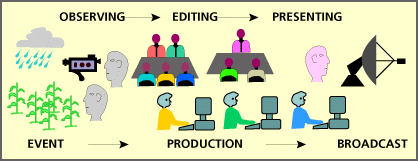

 TUTORIAL: MASS COMMUNICATION
TUTORIAL: MASS COMMUNICATIONINTRODUCTION . TEXT . TEXT AND MEANING . DATA AS TEXT . THE MASS MEDIA . CHANNELS OF DISTRIBUTION . THE AUDIENCE . MEDIA ORGANIZATIONS . CONTENT . SOCIAL INSTITUTIONS .
For example, the author of a book, may produce the initial set of words, but an editor (or editors) will review and alter those words, designers and graphics specialists will choose type faces, create illustrations and organize the format of the text, production specialists will manufacture the book, and marketing and sales specialists will oversee its distribution. Although it is traditional to assign "authorship" to the person who wrote the original text, all of these people play a part in the communication process.
Electronic media are even more complexly organized. In a television production, for example, there will be one or more scriptwriters, a number of actors, a producer, a director, camera operators and other technical crew, and a host of others. A television show is truly a group project, with no single "author."
Yet, to say that mass communication is produced by an organization is not to say that it is random or "neutral" in terms of the ideas and opinions that are expressed. Readers encounter "liberal" and "conservative" newspapers, for example, or religiously-oriented television programming, or politically-oriented music. Thus, a discussion of mass communication must investigate the nature of the organizations that produce it, and it must also investigate the social, political and economic relationships that might exist among the media organizations and their audiences.
With the recognition of the active audience has come the realization that the content of the mass media is actually a product. No less than soap or breakfast cereal or automobiles, mass communication is produced and distributed for human consumption.
This means, of course, that the mass media organizations have something to sell, and that the audiences are their customers. Thus, one approach to the study of mass communication is to focus on the economics of media production. Consider, for example, this outline of the economics of commercial television.

Notice that the members of the audience buy products from corporations. The
remainder of the system has to do with distributing some of that revenue for
the purpose of bring the corporations' products to the attention of the
audience.
![]() 6031
6031
![]() 6035
6035
The media product passes through many levels of organizational processing on its way to the audience, and at each step in the process, the original data is filtered -- reduced in length, edited for style, censored, and so on. Each step in the process can be thought of as a gate through which the data must pass on its way to the consumer, consequently this situation is known as gatekeeping.
Suppose, for example, that a network television news team is sent to the midwestern United States to cover the heavy rains and flooding that are occurring there. The gatekeeping on this story begins with the observation of the event by the news team.
The flood may extend over hundreds of square miles and affect the lives of millions of people, but the team will have time to record only a very small portion of this. Let us say that the team decides to focus on damage being done to the corn crop. This decision filters the available data by including data relating to the corn crop and excluding data relating to other crops and other types of damage.

Within the news organization many people will contribute to the production of
this "story." Editors will select the bits of video to be used in the final
presentation; writers will create a script for the commentator to read; graphic
artists will create titles, maps, animations and other video enhancements;
musicians may create a musical score for the piece and so on. Other editors
will decide which evening the story will "run," and where the story will come
in the sequence of stories, advertisements, and other material running that
night. An anchorperson will introduce the story and various technicians will
insure that it gets "on the air."
![]() 6015.
6015.
![]() 6032
6032
During its stay in the flood zone, the news team may have shot hours of video tape, gathered many facts and interviewed many people. Yet the story as broadcast, if it is broadcast at all, will be only minutes in length. And, each gatekeeper will have had an effect on the content and style of the story. Each person will have added to or subtracted from the original data, and in his or her own way each person will have helped to formulate this particular communication product.
In recent decades media researchers have been able to demonstrate an indirect, but nonetheless powerful, connection between what the news media presents and what people think. This connection has been dubbed agenda setting.
In investigating the relationship between the top stories in the news and "what people are talking about," communication researchers found that stories tend to appear in the news somewhat prior to their becoming widely discussed among the public at large.
The conclusion we might draw from this is that the media tend to set the "agenda" -- the list of items that people will be discussing. Thus, the power of the media may lie not in its ability to sway people's opinions, but rather in its role of determining what issues will be considered important enough to discuss.

Agenda setting connects the constant use of the media in our society with the results of studies that show that most people form their opinions and beliefs based on face-to-face communication with others. It has become a widely accepted theory of mass communication.
These categories of content may be further divided. Entertainment, for example, might be divided into "genres" such as situation comedies, detective shows, soap operas, sports, and so on.
The content of each medium is subject to analysis and criticism by its readers. "Literary criticism," "film criticism," and "television criticism" are all well established fields of academic study, and some members of mass media organizations make their livings by publishing their critical views.
Because most readers will
have been exposed to literary criticism in school, and because many critiques of film and television content are widely available, the topic will not be pursued further in this tutorial.
![]() 6025
6025
For example, the person who edits a newspaper story may be in the audience of a radio broadcast. The radio technician may be in the television audience. The television producer may read the newspaper. And, all of these people may talk to one another about what they have watched and heard and read.
Thus, "mass communication" and "interpersonal communication" seem to merge into one another. The next section of tutorial takes up the discussion of this situation.
![]() 6005
6005
![]() 6027
6027